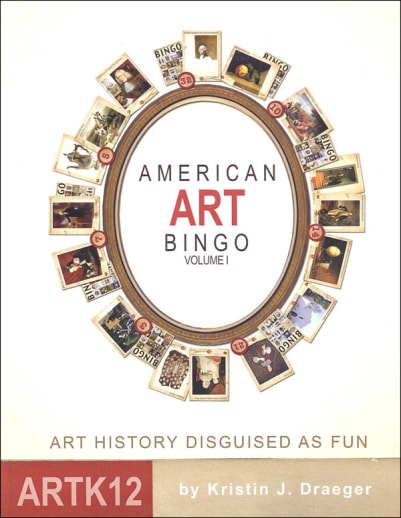Not only is this the only American art history course that I have ever seen for homeschool use, but it may be one of the most original approaches to art history that I have seen. The covers boldly state that it is "Art history disguised as fun," which might explain why the lesson text is presented in the form of a faux newspaper (complete with ads!), why playing "spot the differences" is incorporated into each lesson, and why there is bingo in each lesson!
Each volume holds 16 lessons, designed for one semester. Volumes 1 and 2 make up one year of American art history and would work well in a year where you were also studying American history. There are three books for each volume. Each lesson starts with American Art Bingo. Then youll read the "lesson" in American Art History (presented in the form of a newspaper) and compare original works of art with "forgeries." The last step is in Drawing American Art, where students create their own version of a famous work of art from that period.
Lets look closer at each of the three books. American Art Bingo comes in the form of a softcover book, but you will need to take it apart to use it as a game. It holds full-page reproductions of 32 famous works of art and 20 bingo cards. You will need to provide the counters or chips. The beginning of the book holds basic instructions and suggested bingo variations. By the end of each semester, students should be able to easily recognize 32 works of American art!
Ready for more fun? Read the chapters in American Art History to learn more about the culture, the period in history, and details about featured artists all in newspaper form. For example, in the chapter on Early Colonial Portraiture, the lead article in the "Boston Babbler" discusses the popularity of the "flat" portrait style and why kings, queens and aristocrats are "above" mundane things like shadows and perspective. An art expert interviewed for the article, Tritoo Impressmie, takes us back to the Roman and Medieval roots of the style. A second article discusses the featured portraits further and shares a tidbit about how the original portraits were later altered to include an infant daughter. The third article, an interview with another art critic, Mr. Nohzinthuh Ayer, introduces a third portrait from this period. An ad for a poetry reading and a wanted ad for a "3D person seeking a 2D portrait" rounds out the lesson. There are also three activities (one for each portrait), in which the student is asked to find ten differences between the original and the forgery. Im impressed at the amount of information that is woven into the (very) humorous articles, and have found myself laughing at some of the commentary, names and advertisements included. If youre looking for something dry and straightforward, this is probably not the program you are looking for! As a parent, you will probably want to preview the book a bit before you crack it open and read it together, just to be prepared. You, like me, may be confused at first where is the lesson? Its there its just cleverly camouflaged and full of tidbits that your students will find hilarious. In the early chapters on pre-Columbian art, the newspaper ads are full of hunting tools, carved slabs, and apparel, and the myths that explain the relics are woven into the newspaper articles.
The last step in each lesson is drawing. In Drawing American Art, students will complete a step-by-step drawing based on artwork that they studied in the lesson. They start with a template, which can be copied from the master in the back of the book, or downloaded from the publishers website. Step-by-step instructions follow, similar to many "how to draw" instructions with new lines to be added colored in red. The last step is coloring the project to resemble the original. Supplies required are minimal: a pencil and eraser, an ultra-fine black permanent marker, and colored pencils (or crayons or markers). The finished drawing would make a great addition to a portfolio or a history notebook!
Volume I covers prehistoric art (Clovis spear points and other Clovis artifacts) up through the art of Gilbert Stuart (portraits of George Washington). Volume 2 covers American art through sixteen American artists, including Joshua Johnson, Audubon, James Whistler, Mary Cassatt, John Singer Sargent, Frank Lloyd Wright and Georgia OKeeffe.
The author, Kristin J. Draeger (also the author of ArtK12s Draw the World), taught art history to homeschooled students for years, and translated many of her students favorite activities to this curriculum. It shows! The course is designed for grades 3-8, but siblings that are older or younger may also wish to join in! At a pace of one lesson per week, the course is very doable, and as a mom I appreciate that the simple drawing projects help to cement the master artworks into the memory, not necessarily recreate each one in its original medium. The activities are simple and straightforward (little teacher prep required), the lessons are entertaining, and all of the books are high-quality and well-designed. If you spend a little time getting to know this one, Im pretty sure you will be as enthusiastic as your students about this program! Jess
The art history curriculum is designed to be used once a week for a 16 week semester; each week's lesson takes about 2 hours and is very easy to teach - no preparation involved at all. There are three books for each semester. You simply:
1. Play the bingo game
2. Read the chapter in American Art History
3. Draw the piece of art.
Only one set is needed per family.

